#arctic race of norway
Explore tagged Tumblr posts
Text





Arctic Race of Norway 2023 Stage 4 | Kvalsund › Nordkapp (171.4km) 📸 by Luc Claessen/Getty Image
41 notes
·
View notes
Text
Arctic Raice of Norway: Over 120 XPENG-biler inntar Nord-Norge
Elbil- og teknologiprodusenten XPENG er bilpartner for Arctic Race of Norway 2023. Dette betyr at Arctic Race of Norway blir verdens første helelektirske sykkelritt med kun elektriske følgebiler. Nå begynner bilene som skal følge rytterne i verdens nordligste sykkelritt å ankomme Alta. Til sammen vil det ankomme over 120 biler til Alta frem til bilene skal dekoreres 9. august. Da skal alle…

View On WordPress
0 notes
Note
4 FOR LANDOSCAR DUH!
give me a number between 1-100 and a pairing, i'll write a drabble* based on that song
*(actual word count may vary)
Lando had heard, when two people fall in love, it went like this: one fell first, the other fell harder. He’d always been the one to fall first, so when Oscar had stood beside him as his teammate for the first time, both decked out in their papaya race suits, he assumed that they were destined to be friends. He always fell first, so this should be no different. If he wasn’t falling, then there was nowhere to fall.
He’d missed the fond looks Oscar gave him, the way that his eyes lit up like he was the reason the sun rose in the mornings, and the reason that the stars shone at night. He missed the way that he licked his lips as his eyes roamed over his body. He missed the fact that, no matter how terribly unfunny he was, Oscar was always laughing around him.
It wasn’t until the car was something they could work with, until they were both consistently scoring points - good points - that he noticed.
Suzuka. On the podium. When Oscar was approaching him with champagne spraying from the bottle and drenching him head to toe.
Something awakened deep within Lando, and to say that he fell hard would be an understatement. It was as if someone had thrown him off the top of a mountain in Norway, far above the Arctic circle, and he’d tumbled and tumbled and tumbled until he lay on his back at the bottom of a valley and stared back up at the northern lights themselves. The champagne was ice cold, but his body felt impossibly warm. His cheeks turned pink as he laughed and sprayed Oscar back.
He’d been totally and utterly defeated, and had no choice but to lay his weapons down. Oscar had conquered him and he hadn’t even realised it. Now all he could do was wait to see just how far he’d go.
30 notes
·
View notes
Text


Polar lights somewhere above Norway's arctic circle on a mountain.
The above is how the camera sees the northern lights after being able to expose the night sky and capture the lights for (in this case) 15 seconds.
The human eye however, obviously cannot see the northern lights with the same intensity of a prologed exposure and in general it's dark vision is usually not good enough to perceive the colors of the aurora, unless you've got a crazy high activity. Most of the time you'll only see shades of grey and white, or a very very faint tint. The second picture is closer to what my eyes actually saw when I took the photo.
However, even without color they're beautiful to witness and can turn into a spectacle no still image could ever capture. The strongest aurora I've ever witnessed was pale green and like pure light was dancing and racing between the stars and raining down on me. It's like experiencing magic.
11 notes
·
View notes
Text

"For long periods of time, the Sámi lifestyle thrived because of its adaptation to the Arctic environment. Indeed, throughout the 18th century, as Norwegians of Northern Norway suffered from low fish prices and consequent depopulation, the Sámi cultural element was strengthened, since the Sámi were mostly independent of supplies from Southern Norway.
During the 19th century, the pressure of Christianization of the Sámi increased, with some Sámi adopting Laestadianism. With the introduction of seven compulsory years of school in 1889, the Sámi language and traditional way of life came increasingly under pressure from forced cultural normalization. Strong economic development of the north also ensued, giving Norwegian culture and language higher status
On the Swedish and Finnish sides, the authorities were less militant, although the Sámi language was forbidden in schools and strong economic development in the north led to weakened cultural and economic status for the Sámi. From 1913 to 1920, the Swedish race-segregation political movement created a race-based biological institute that collected research material from living people and graves. Throughout history, Swedish settlers were encouraged to move to the northern regions through incentives such as land and water rights, tax allowances, and military exemptions
The strongest pressure took place from around 1900 to 1940, when Norway invested considerable money and effort to assimilate Sámi culture. Anyone who wanted to buy or lease state lands for agriculture in Finnmark had to prove knowledge of the Norwegian language and had to register with a Norwegian name. This partly caused the dislocation of Sámi people in the 1920s, which increased the gap between local Sámi groups (something still present today) that sometimes has the character of an internal Sámi ethnic conflict. Another example of forced displacement occurred between 1919 and 1920 in Norway and Sweden. This has been the topic of a recent work of journalism by Sámi author Elin Anna Labba, translated into English in 2023 under the title The Rocks Will Echo Our Sorrow: The Forced Displacement of the Northern Sámi.
In 1913, the Norwegian parliament passed a bill on "native act land" to allocate the best and most useful lands to Norwegian settlers. Another factor was the scorched earth policy conducted by the German army, resulting in heavy war destruction in northern Finland and northern Norway in 1944–45, destroying all existing houses, or kota, and visible traces of Sámi culture. After World War II, the pressure was relaxed, though the legacy was evident into recent times, such as the 1970s law limiting the size of any house Sámi people were allowed to build
The controversy over the construction of the hydro-electric power station in Alta Municipality in 1979 brought Sámi rights onto the political agenda. In August 1986, the national anthem ("Sámi soga lávlla") and flag (Sámi flag) of the Sámi people were created. In 1989, the first Sámi parliament in Norway was elected. In 2005, the Finnmark Act was passed in the Norwegian parliament giving the Sámi parliament and the Finnmark Provincial council a joint responsibility of administering the land areas previously considered state property. These areas (96% of the provincial area), which have always been used primarily by the Sámi, now belong officially to the people of the province, whether Sámi or Norwegian, and not to the Norwegian state"
-wikipedia
2 notes
·
View notes
Text
FURIA season 2
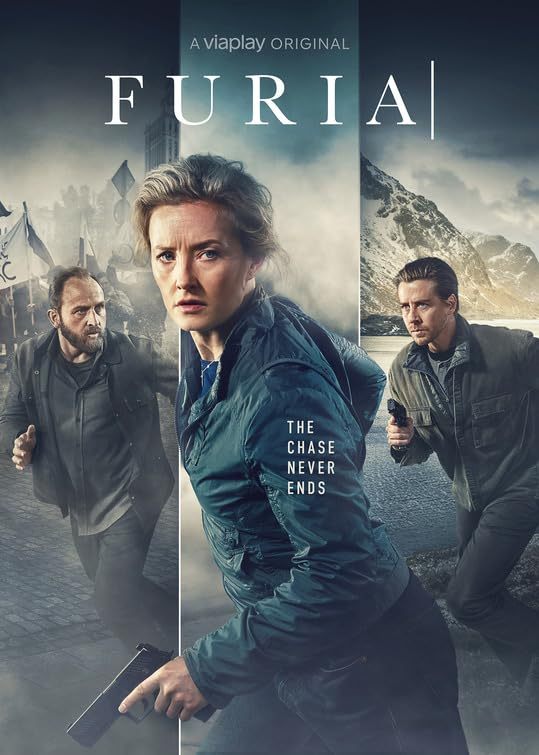
The second season of "Furia" takes place two years after the first.
Furia resurrects, and once again, undercover agents Ragna and Asgeir must fight the notorious right-wing terrorists that threaten Europe with destruction. Ragna’s true identity is revealed to the world by someone trying to frame her, making everyone believe she is Furia, the right-wing terrorist she is battling. She is now both the hunter and the hunted. With her uncompromising partner, Asgeir, by her side, she is forced into a race against time to foil a new terrorist plot that takes them from the Arctic to Budapest and into the heart of Warsaw.
Episode 1: The Revolution Will Be Televised

Asgeir is in Lofoten, where he follows a money trail to get a hold of Ziminov; Ellen is on leave, but she is restless and eager to return to work; the growing number of online threats against Jonas worries the Ministry of Justice.
Episode 2: Polarize and Mobilize

New clues lead Ellen and Asgeir to Budapest, where they are to arrest Ziminov with the CIA's help; Chief and Ellen are concerned about Asgeir's behaviour when he will face Zimino; Jonas must meet with PST with regard to his own safety.
Episode 3: Enemies of the States

When Ellen and Asgeir learn they have fallen into a trap, they must make an unlikely ally to escape; the Minister of Justice and the PST face repercussions of Budapest's events; Tarje gets new information that completely changes his life.
Episode 4: The Medium Is the Message

Ellen goes undercover to track down the infamous Mateusz Krajewski; Ziminov and Asgeir run into difficulties at the border; in Norway, Tarje is in a tough spot where he has to choose between being loyal to his sister and his best mate.
Episode 5: Everything You Love Must Die

Ellen has taken Krajewski and his wife hostages; Tereza and Asgeir infiltrate a highly guarded warehouse in order to find proof; the NATO summit put the Norwegian government under pressure; the Minister of Justice has bad news for Jonas.
Episode 6: The Past Is Never Dead. It's Not Even Past

Poland is in revolt and the European democracy is in jeopardy; Ellen attempts to stop the attack; Asgeir asks Chief to help him; the NATO summit is about to begin as the Minister of Justice makes a crucial decision.
IMDb
16 notes
·
View notes
Photo
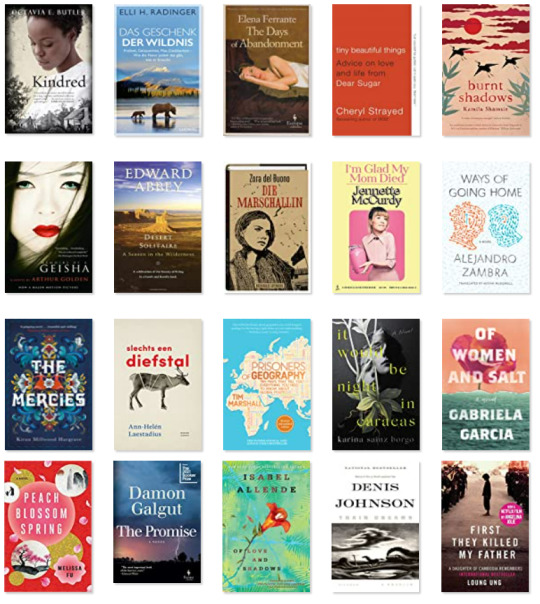
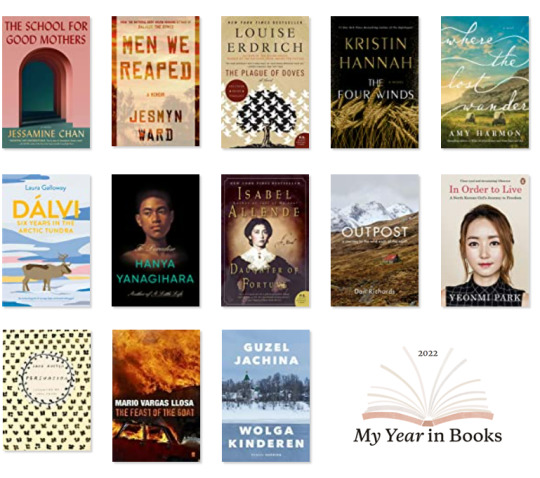
My Year in Books 2022:
11,299 pages read
33 books read
Children of the Volga/My Children by Guzel Yakinha
historical fiction, life, solitude
set in Russia (German colony Gnadenthal) between 1910s-1940s
main characters: Jakob Bach, Klara Grimm, Anna Bach
The Feast of the Goat by Mario Vargas Llosa
historical fiction, politics, betrayal
set in Dominican Republic in 1960s + 1990s
main characters: Urania Cabral, Augustín Cabral, Rafael Trujillo
Persuasion by Jane Austen
historical fiction, romance
set in United Kingdom (Somerset) in 1814-15
main characters: Anne Elliott, Frederick Wentworth, Lady Russell
In Order to Live by Yeonmi Park
nonfiction, memoir, oppression, human trafficking, survival
set in North Korea, China, South Korea in 1990s-2000s
Outpost: A Journey to the Wild Ends of the Earth by Dan Richards
nonfiction, memoir, travel
set in Iceland, US, Scotland, France, Japan, Svalbard
Daughter of Fortune by Isabel Allende
historical fiction, romance
set in Chile (Valparaíso), US (San Francisco) between 1843-1853
main characters: Eliza Sommers, Rose Sommers, Joaquín Andieta, Tao Chi'en
To Paradise by Hanya Yanagihara
fiction, dystopia, family, relationships
set in US (New York, Hawaii) in 1893, 1993 & 2093
main characters: David Bingham, Kawika Bingham, Charlie Bingham-Griffith
Dálvi: Six Years in the Arctic Tundra by Laura Galloway
nonfiction, memoir, introspection, Sámi, nature
set in northern Norway
Where the Lost Wander by Amy Harmon
historical fiction, romance, western
set in US (Missouri, Nebraska, Wyoming) between 1853-1858
main characters: Naomi May, John Lowry
The Four Winds by Kristin Hannah
historical fiction, family, hardship, Great Depression
set in US (Texas, California) in 1921 & 1934-1940
main characters: Elsa Martinelli, Loreda Martinelli, Anthony Martinelli
The Plague of Doves by Louise Erdrich
historical fiction, Indigenous, mystery
set in US (North Dakota) in 1960s, 1970s and before
main characters: Evelina Harp, Mooshum Milk, Antone Bazil Coutts
Men We Reaped by Jesmyn Ward
nonfiction, memoir, race, grief
set in US (Mississippi) between 1970s-2000s
The School for Good Mothers by Jessamine Chan
fiction, dystopia, motherhood
set in future US (Philadelphia)
main characters: Frida Liu, Harriet, Gust
First They Killed My Father: A Daughter of Cambodia Remembers by Loung Ung
nonfiction, memoir, war, Khmer Rouge, family, survival
set in Cambodia between 1975-1980
Train Dreams by Denis Johnson
historical fiction, solitude, western
set in US (Idaho) between 1910s-1930s
main character: Robert Grainier
Of Love and Shadows by Isabel Allende
historical fiction, romance, dictatorship
set in Chile in 1970s
main characters: Irene Beltrán, Francisco Leal
The Promise by Damon Galgut
(historical) fiction, family, grief, race
set in South Africa (Pretoria) in 1986, 1995, 1999, 2017
main characters: Amor Swart, Anton Swart, Astrid Swart
Peach Blossom Spring by Melissa Fu
historical fiction, family, survival, immigration, identity
set in China, Taiwan, US (Illinois, New Mexico) between 1938-2005
main characters: Meilin, Renshu/Henry, Longwei, Lily
Of Women and Salt by Gabriela Garcia
(historical) fiction, family, immigration, deportation
set in Cuba, US (Florida, Texas), Mexico between 1866-2019
main characters: Jeanette, Carmen, Gloria Ramos, Ana
It Would Be Night in Caracas by Karina Sainz Borgo
fiction, social unrest, oppression, grief
set in Venezuela
main character: Adelaida Falcón
Prisoners of Geography: Ten Maps That Tell You Everything You Need To Know About Global Politics by Tim Marshall
nonfiction, geopolitics, history, international relations
set worldwide
Stolen (Stöld) by Ann-Helén Laestadius
fiction, Sámi, discrimination, crime, family
set in northern Sweden
main character: Elsa
The Mercies by Kiran Millwood Hargrave
historical fiction, witch trials, romance
set in northern Norway (Vardø) between 1617-1619
main character: Maren Bergensdatter, Ursula Cornet
Ways of Going Home by Alejandro Zambra
(historical) fiction, identity, politics, dictatorship
set in Chile between 1980s-2000s
characters: nameless protagonist, Claudia, Eme
I’m Glad My Mom Died by Jennette McCurdy
nonfiction, memoir, abuse, mental health, child acting
set in US (LA)
The Marshal (Die Marschallin) by Zora del Buono
historical fiction, family, politics, war
set in Slovenia (Bovec) and Italy (Bari) between 1919-1980
main characters: Zora Ostan, Pietro del Buono
Desert Solitaire by Edward Abbey
nonfiction, nature, environment, national parks
set in US (Utah) in 1960s
Memoirs of a Geisha by Arthur Golden
historical fiction, geisha’s, Japanese culture
set in Japan (Kyoto) in 1930s-1940s
main character: Sakamoto Chiyo/Nitta Sayuri
Burnt Shadows by Kamila Shamsie
historical fiction, romance, family
set in Japan (Nagasaki), India (Delhi), Pakistan (Karachi) in 1945, 1947, 1982-1983, 2001-2002
main characters: Hiroko Tanaka, Sajjad Ali Ashraf, Raza Ashraf, Harry Burton
Tiny Beautiful Things: Advice on Love and Life from Dear Sugar by Cheryl Strayed
nonfiction, self help
The Days of Abandonment by Elena Ferrante
fiction, separation, abandonment
set in Italy (Turin) in 2000s
main character: Olga
The Gift of the Wild (Das Geschenk der Wildnis) by Elli H. Radinger
nonfiction, nature, animals, environment
set in US (Montana, Wyoming, Alaska, Arizona, Minnesota, Massachusetts, Texas), Germany
Kindred by Octavia E. Butler
historical fiction, sci-fi, time travel, race, slavery
set in US (California and Maryland) in 1810s-1820s and 1976
Main characters: Dana Franklin, Kevin Franklin, Rufus Weylin, Alice Greenwood
8 notes
·
View notes
Text
What Arknights thinks you are, based on where you come from
Arknights doesn't usually have real-world races, but it has obvious counterparts to real-world nationalities. Sometimes painfully obvious.
If the only example of a species makes sense for its region, I count it. If the only example makes no sense, like an Indian Grey Moongoose from the Russia equivalent or a Feathered Serpent in the U.S., I don't count it. Them's the breaks.
Anywhere: Bird, Rat, Snake, Lizard, Tiger
U.S.A: Fox, Otter, Robot
South America (Not Indigenous): Dog
Amazon (Indigenous): Crocodile
Britain or France or Scotland: Cat, Lion, Wyvern, Western Dragon, Unicorn
Poland: Horse, Pegasus
Spain or Seasteader: A very wide variety of sea creatures
Basque Country: Dwarf
Germany: Goat, European Fallow Deer, Wolf if you happen to be a Wolfgang Amadeus Mozart reference.
Italy (Mafia): Wolf, sometimes Fox
Italy (Catholic) or Switzerland: Angel
Tibet or Norway or also Switzerland: Yak, Musk Deer, Snow Leopard, Jormungandr
Greece: Cow
Eastern Europe (Jewish): Demon, Goliath. (Yes, this gets offensive sometimes)
Eastern Europe (kinda Jewish, but kinda doing their own thing): Lots of different "monsters" like Vampire or Gargoyle.
Somewhere in Africa or the Middle East, all squashed together: Camel, Zebra, Hyena, Frog, Rhino, Manticore, a couple of cat breeds.
Russia: Bear
China: Panda, Gaur, Yangtze Finless Porpoise, almost anything from Buddhist or Chinese mythology
Japan: Oni, Shiba Inu, Kitsune, Nue, Kamaitachi
Either China or Japan: Sika Deer.
Mongolia: Nightmare (technically, these are also squished into the Africa/Middle East hybrid)
Australia: Rabbit
Anywhere cold and northern that's stereotypically "primitive" or "Native": Deer, Arctic Fox, Norwegian Forest Cat, supposedly Cyclops but seems more like Norn
I don't even know: Yithian
1 note
·
View note
Text
Liked on YouTube: When You Thought it's a Holiday then Suddenly You're Sprinting | Arctic Race of Norway 2024 Stage 1
When You Thought it’s a Holiday then Suddenly You’re Sprinting | Arctic Race of Norway 2024 Stage 1 Lanterne Rouge presents highlights of Arctic Race of Norway 2024 Stage 1. Become a channel member | https://www.youtube.com/channel/UC77UtoyivVHkpApL0wGfH5w/join Join the discord | https://ift.tt/HKYpPCN For more in-depth professional cycling analysis check out the Lanterne Rouge Cycling Podcast |…
0 notes
Text
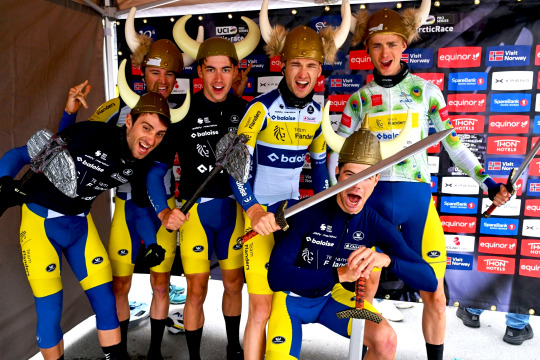

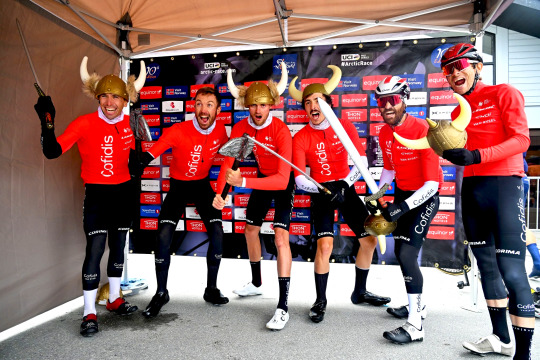
Arctic Race of Norway 2023 - Stage 4 📸 by Luc Claessen/Getty Images & arcticraceofn
#team flanders baloise#team dsm fermenich#cofidis#cycling#arctic race of norway#arctic race of norway 2023
21 notes
·
View notes
Text
Sykkelstafett gjennom Nord-Norge: - Folk finner på all verdens sprell
Sykkelen til Arctic Race of Norway har kommet et godt stykke opp i Nordland, og har vært med på både rafting og toppturer. I forbindelse med at det er 10 år siden første utgave av Arctic Race of Norway, har alle kommunene i Nord-Norge tatt på seg oppdraget med å frakte en sykkel fra Bindal lengst sør til Nordkapp i nord. Daglig leder i Arctic Race of Norway er full av lovord over alt sykkelen…

View On WordPress
0 notes
Text
"Togo: The Unsung Hero of the 1925 Serum Run"

Togo, a Siberian Husky, was born on September 17, 1913, and passed away on December 5, 1929. He became famous as the lead sled dog in the 1925 serum run to Nome, Alaska, under the ownership of Leonhard Seppala, a celebrated musher. The name "Togo" translates from the Ewe language as "at the rear of the river."
In 1925, a deadly diphtheria outbreak hit Nome, threatening the lives of over 10,000 residents, particularly children. With the town isolated, the only way to deliver the life-saving serum was through sled dog teams. Togo led Seppala's team during this critical mission, covering an incredible 264 miles in just five and a half days. Despite facing extreme weather conditions, Togo and Seppala successfully delivered the serum to Nome, saving numerous lives.
Although another sled dog named Balto received more immediate recognition for the serum run, historians argue that Togo was the true hero of the mission. Over time, Togo's contribution gained recognition, leading to the unveiling of his own statue in New York City's Seward Park in 2001. Togo's story highlights the vital role of sled dogs, particularly Siberian Huskies, in Arctic exploration and events like the Iditarod race.
Leonhard Seppala, originally from Norway, arrived in Alaska in 1900 and became one of the most respected mushers in Nome. He played a crucial role in popularizing Siberian Huskies in the United States, recognizing their endurance and strength.
After retiring, Togo lived at the Ricker Kennel in Poland Spring, Maine. He was euthanized by Seppala on December 5, 1929, at the age of 16 due to joint pain and partial visual impairment. Togo's preserved skin was displayed at the Shelburne Museum in Shelburne, Vermont, serving as a testament to his remarkable life and legacy.
Overall, Togo's story is a powerful example of bravery, loyalty, and the enduring bond between humans and dogs, leaving a lasting impact on the history of sled dog racing and Arctic exploration.
For more details, visit the original article here
1 note
·
View note
Text
norway
21 Interesting Facts About Norway:
1. Norway's fjords aren't just majestic vistas; they hide secret passages and hidden caves where adventurers can uncover ancient Viking treasures and mysterious artifacts.
2. The Northern Lights aren't just a beautiful sight; they hold a secret energy that some locals believe can awaken latent abilities in those who witness their shimmering dance.
3. Among Bergen's seven mountains lies a hidden network of tunnels and caverns, rumored to be home to mythical creatures and lost civilizations waiting to be discovered.
4. Deep within the Lærdal Tunnel, there are whispers of a forgotten underground city, illuminated by crystals that emit an otherworldly glow, drawing daring explorers into its depths.
5. Oslo's Vigeland Park isn't just a showcase of sculptures; it's rumored to be a portal to another dimension, where the statues come alive at night, engaging in mysterious rituals.
6. The "Turistforeningen" trails hold more than scenic views; they conceal ancient runes and markings left by a long-forgotten civilization, hinting at secrets waiting to be deciphered.
7. The Lofoten Islands aren't just a picturesque destination; they harbor hidden pirate coves and smuggler's dens, where tales of buried treasure and ghostly apparitions abound.
8. Norway's ski culture isn't just a sport; it's a mystical tradition passed down through generations, with whispers of enchanted slopes and bewitched forests that come alive at dusk.
9. The Tall Ships Races aren't just maritime competitions; they're gatherings of seafaring spirits from ages past, sailing the seas in search of lost realms and mythical lands.
10. Traditional Norwegian cuisine isn't just food; it's a culinary journey through time, with recipes that hold the secrets of ancient rituals and mystical ingredients found only in the most remote corners of the wilderness.
11. The Viking Ship Museum isn't just a repository of artifacts; it's a gateway to the Viking realm, where visitors can step aboard ghostly longships and embark on voyages to the realms of gods and giants.
12. Norway's waterfalls aren't just natural wonders; they're portals to hidden realms and mystical dimensions, where nymphs and spirits frolic in the cascading waters under the light of the full moon.
13. The fjords aren't just stunning landscapes; they're guardians of ancient wisdom and sacred knowledge, with hidden passages that lead to realms beyond the mortal realm.
14. Norway's Arctic regions aren't just wilderness; they're realms of magic and mystery, where the spirits of the wild roam free and the aurora borealis dances with otherworldly grace.
15. The Oslo Opera House isn't just an architectural marvel; it's a gateway to the realm of dreams, where performers harness the power of music to transcend the boundaries of reality.
16. Norway's stave churches aren't just historic landmarks; they're sanctuaries of ancient magic, with carvings and symbols that hold the keys to unlocking hidden powers and ancient prophecies.
17.Coastal villages aren't just quaint communities; they're hubs of supernatural activity, where mermaids sing enchanting songs and sea monsters lurk in the depths.
18. The "Electricity Highway" isn't just a power grid; it's a conduit for mystical energies, channeling the power of the elements to fuel ancient rituals and sacred ceremonies.
19. Sami culture isn't just a heritage; it's a connection to the spirit world, with rituals and traditions that bridge the gap between the mortal realm and the realm of the ancestors.
20. Norway's fishing industry isn't just a livelihood; it's a quest for hidden knowledge, with fishermen seeking out secret fishing grounds said to be guarded by ancient sea spirits.
21. Winter sports aren't just recreational activities; they're rites of passage, where adventurers brave the elements to commune with the spirits of winter and unlock the secrets of the frozen wilderness.
0 notes
Text
This Arctic Circle Town Expected a Green Energy Boom. Then Came Bidenomics.
Generous subsidies are helping the United States steal green industries from Europe, as countries race to secure the energy supplies of the future. source https://www.nytimes.com/2024/02/13/business/economy/norway-inflation-reduction-act.html
View On WordPress
0 notes
Text
Events 2.9 (before 1950)
474 – Zeno is crowned as co-emperor of the Byzantine Empire. 1003 – Boleslaus III is restored to authority with armed support from Bolesław I the Brave of Poland. 1098 – A First Crusade army led by Bohemond of Taranto wins a major battle against the Seljuq emir Ridwan of Aleppo during the siege of Antioch. 1539 – The first recorded race is held on Chester Racecourse, known as the Roodee. 1555 – Bishop of Gloucester John Hooper is burned at the stake. 1621 – Gregory XV becomes Pope, the last Pope elected by acclamation. 1654 – The Capture of Fort Rocher takes place during the Anglo-Spanish War. 1775 – American Revolutionary War: The British Parliament declares Massachusetts in rebellion. 1778 – Rhode Island becomes the fourth US state to ratify the Articles of Confederation. 1822 – Haiti attacks the newly established Dominican Republic on the other side of the island of Hispaniola. 1825 – After no candidate receives a majority of electoral votes in the US presidential election of 1824, the United States House of Representatives elects John Quincy Adams as sixth President of the United States in a contingent election. 1849 – The new Roman Republic is declared. 1861 – American Civil War: Jefferson Davis is elected the Provisional President of the Confederate States of America by the Provisional Confederate Congress at Montgomery, Alabama 1870 – US president Ulysses S. Grant signs a joint resolution of Congress establishing the U.S. Weather Bureau. 1889 – US president Grover Cleveland signs a bill elevating the United States Department of Agriculture to a Cabinet-level agency. 1893 – Verdi's last opera, Falstaff premieres at La Scala, Milan. 1895 – William G. Morgan creates a game called Mintonette, which soon comes to be referred to as volleyball. 1900 – The Davis Cup competition is established. 1904 – Russo-Japanese War: Battle of Port Arthur concludes. 1907 – The Mud March is the first large procession organised by the National Union of Women's Suffrage Societies (NUWSS). 1913 – A group of meteors is visible across much of the eastern seaboard of the Americas, leading astronomers to conclude the source had been a small, short-lived natural satellite of the Earth. 1920 – Under the terms of the Svalbard Treaty, international diplomacy recognizes Norwegian sovereignty over Arctic archipelago Svalbard, and designates it as demilitarized. 1922 – Brazil becomes a member of the Berne Convention copyright treaty. 1929 – Members of the Việt Nam Quốc Dân Đảng assassinate the labor recruiter Bazin, prompting a crackdown by French colonial authorities. 1932 – Prohibition law is abolished in Finland after a national referendum, where 70% voted for a repeal of the law. 1934 – The Balkan Entente is formed between Greece, Romania, Yugoslavia, and Turkey. 1941 – World War II: Bombing of Genoa: The Cathedral of San Lorenzo in Genoa, Italy, is struck by a bomb which fails to detonate. 1942 – Year-round Daylight saving time (aka War Time) is reinstated in the United States as a wartime measure to help conserve energy resources. 1943 – World War II: Pacific War: Allied authorities declare Guadalcanal secure after Imperial Japan evacuates its remaining forces from the island, ending the Battle of Guadalcanal. 1945 – World War II: Battle of the Atlantic: HMS Venturer sinks U-864 off the coast of Fedje, Norway, in a rare instance of submarine-to-submarine combat. 1945 – World War II: A force of Allied aircraft unsuccessfully attack a German destroyer in Førdefjorden, Norway.
0 notes
Text
Tuesday, August 1, 2023
Two supermoons in August mean double the stargazing fun (AP) The cosmos is offering up a double feature in August: a pair of supermoons culminating in a rare blue moon. Catch the first show Tuesday evening as the full moon rises in the southeast, appearing slightly brighter and bigger than normal. That’s because it will be closer than usual, just 222,159 miles (357,530 kilometers) away, thus the supermoon label. The moon will be even closer the night of Aug. 30—a scant 222,043 miles (357,344 kilometers) distant. Because it’s the second full moon in the same month, it will be what’s called a blue moon. The last time two full supermoons graced the sky in the same month was in 2018. It won’t happen again until 2037.
The Race for the Melting Arctic (WSJ) On patrol in the Bering Sea last fall, the U.S. Coast Guard Cutter Kimball spotted seven Chinese and Russian vessels steaming through the frigid waters in a double line near Alaska’s Aleutian Islands. Russian warships and Chinese research vessels aren’t uncommon in a region that includes the Aleutians, a strategic chain of volcanic islands that divides the Pacific Ocean from the Bering Sea and Arctic Ocean. “But to see these combatants form up in a surface action group together and steam together, that’s what’s rare,” said Rear Adm. Nathan Moore. Once a lonely and largely impassable maritime expanse where countries worked together to extract natural resources, the Arctic is increasingly contested territory. As sea ice melts and traffic increases on the southern edges of the Arctic Ocean, governments are maneuvering in ways that mirror the great-power rivalries seen in lower latitudes. In recent months, Russian bombers have increased their patrols over the Arctic and have probed further south. Norway’s intelligence service said that with Russia’s conventional forces weakened by the war in Ukraine, its strategic weapons are taking on greater importance, among them the nuclear-armed submarines of Russia’s Northern Fleet. More Russian-flagged commercial and government vessels are active in Arctic waters. In response, the U.S. is beefing up its presence in the Arctic by adding to its polar icebreakers. The U.S. has just one icebreaker in the region for only part of the year, compared with three dozen owned by Russia.
Heat Is Costing the U.S. Economy Billions in Lost Productivity (NYT) As much of the United States swelters under record heat, Amazon drivers and warehouse workers have gone on strike in part to protest working conditions that can exceed 100 degrees Fahrenheit. On triple-digit days in Orlando, utility crews are postponing checks for gas leaks, since digging outdoors dressed in heavy safety gear could endanger their lives. Even in Michigan, on the nation’s northern border, construction crews are working shortened days because of heat. Extreme heat is regularly affecting workers beyond expected industries like agriculture and construction. Sizzling temperatures are causing problems for those who work in factories, warehouses and restaurants and also for employees of airlines and telecommunications firms, delivery services and energy companies. The cost is high. In 2021, more than 2.5 billion hours of labor in the U.S. agriculture, construction, manufacturing, and service sectors were lost to heat exposure, according to data compiled by The Lancet. Another report found that in 2020, the loss of labor as a result of heat exposure cost the economy about $100 billion, a figure projected to grow to $500 billion annually by 2050.
Miami’s Overflowing Septic Tanks and Trash Piles Test Appeal to Rich (Bloomberg) Miami wants to attract even more out-of-state workers and wealthy newcomers like hedge fund tycoon Ken Griffin. But first, County Mayor Daniella Levine Cava faces a huge environmental problem: overflowing garbage heaps and septic tanks. Some of greater Miami’s massive landfills, known by clever names like Mount Trashmore, will run out of space by 2026, according to a report from Cava’s office. More urgent are the septic systems that serve the city’s 2.7 million residents. Many of those front-yard sewage tanks overflow when it rains, releasing fecal bacteria and other contaminants that transform patches of tropical paradise into toxic swamps that kill fish and sicken people.
‘You do it or we do it’ (NYT) Mexico has been one of America’s closest allies for years under both Democratic and Republican administrations, even Donald Trump’s. That may be changing. Republican officials and voters have not only expressed criticisms of Mexico but also outright hostility against America’s southern neighbor. The starkest example involves repeated calls by Republican presidential candidates to bomb Mexico or unilaterally send troops there to stop the illegal drug trade, which would be an act of war. Trump led the way: He asked defense officials about striking Mexico with missiles while he was president, and during the 2024 presidential campaign he has supported military action. Ron DeSantis has called for using deadly force and a naval blockade of Mexican ports to stop drug traffickers. More moderate candidates, like Tim Scott and Nikki Haley, have also backed using the military against drug cartels in Mexico. “You know what you tell the Mexican president? ‘Either you do it or we do it,’” Haley said in March. “But we are not going to let all of this lawlessness continue to happen.” “In 35 years, this takes the prize as the stupidest idea I have ever heard,” said Jonathan Caulkins at Carnegie Mellon University. In addition to the likely humanitarian toll and the hit to U.S. standing in the world, any incursion into Mexico could worsen the same problems Republicans are trying to address. To the extent that the U.S. has succeeded in stemming illegal immigration and drugs in recent years, it has relied on Mexico’s close cooperation.
In Odesa, Attacks Stoke Hatred of Russia (NYT) Standing on a bridge overlooking the road to Odesa’s main port, Nina Sulzhenko surveyed the damage wrought by a recent Russian missile strike: The House of Scientists, one of the Ukrainian city’s best-loved buildings, was in shambles. The mansion’s destroyed gardens spilled down over a ruined residential complex, and burned bricks lay strewn across the sidewalk. “I feel pain, and I want revenge,” said Ms. Sulzhenko, 74. “I don’t have the words to say what we should do to them.” Hers was a common sentiment in Odesa this past week after a series of missile strikes damaged the city’s port and 29 historic buildings in its Belle Époque city center, including the Transfiguration Cathedral, one of Ukraine’s largest. Odesa plays an important role in the mind of imperial Russians, and especially President Vladimir V. Putin, who views it as an integral part of Russian culture. But if Mr. Putin believed that Odesans would feel a reciprocal bond, he could not have been more mistaken, residents and city officials interviewed this past week said. Especially after the recent spate of missile attacks.
Russia Says 2 Drones Hit Buildings in Moscow in Latest Wave of Attacks (NYT/NBC News) The Russian Defense Ministry said on Sunday that Ukrainian forces had fired at least three drones at Moscow, demonstrating that few places are off limits after more than 17 months of war. One drone was destroyed in Odintsovo, outside Moscow, the Defense Ministry said, adding that two others struck commercial buildings in the capital after being intercepted by Russian air defenses. There were no injuries, Moscow’s mayor, Sergey Sobyanin, said in a post on the Telegram messaging app, but video footage from Russian state media showed blown-out windows and twisted beams in one of Moscow’s premier skyscrapers. Kyiv has stopped short of taking responsibility for the drone attacks, but Ukrainian President Volodymyr Zelenskyy suggested Sunday this could mark a new chapter. “Gradually, the war is returning to the territory of Russia—to its symbolic centers and military bases, and this is an inevitable, natural and absolutely fair process,” Zelenskyy said Sunday in his nightly video address. Last week, a drone fell in the center of the capital near the defense ministry headquarters, while another gutted a few upper floors of another building.
ISIL claims responsibility for Pakistan bombing that killed 54 people (Al Jazeera) The death toll from a massive suicide bombing that targeted an election in the border district of Bajaur has risen to 54, as Pakistan held funerals and the government promised to hunt down those behind the attack. Nearly 200 people were wounded in Sunday’s bombing claimed by the ISIL (ISIS) armed group on Monday. Around 400 members of the Jamiat Ulema-e-Islam (JUI-F) party—a key government coalition partner headed by hardline politician Fazlur Rehman—were waiting on Sunday for speeches to begin when a bomber detonated a vest packed with explosives near the front stage.
11 dead and 27 missing in flooding around Beijing after days of rain (AP) Chinese state media report 11 people have died and 27 are missing amid flooding in the mountains surrounding the capital Beijing. Days of heavy rains have prompted authorities to close train stations and evacuate people in vulnerable communities to school gyms, state broadcaster CCTV reported Tuesday. Homes have been flooded, roads torn apart and cars piled into stacks. The level of rainfall is highly unusual for Beijing, which generally enjoys a moderate, dry climate. Flooding in other parts of northern China that rarely see such large amounts of rain have led to scores of deaths.
Legacy of corruption (Foreign Policy) The head of Lebanon’s central bank stepped down on Monday amid rampant corruption allegations and one of the nation’s worst financial crises in history. Riad Salameh, age 73, served at the country’s economic helm for 30 years. He came to power only three years after the nation’s 15-year civil war ended, at a time when international aid was flooding the country. Under his leadership, though, Lebanon’s currency lost 98 percent of its value, unemployment skyrocketed, and food prices increased by more than 600 percent. Salameh is currently under investigation for embezzlement in numerous countries, having borrowed money to pay existing creditors. He continues to deny the allegations, which many economic experts have compared to a Ponzi scheme.
Thousands take to streets in Gaza in rare public display of discontent with Hamas (AP) Several thousand people briefly took to the streets across the Gaza Strip on Sunday to protest chronic power outages and difficult living conditions, providing a rare public show of discontent with the territory’s Hamas government. Hamas security forces quickly dispersed the gatherings. Marches took place in Gaza City, the southern town of Khan Younis and other locations, chanting “what a shame” and in one place burning Hamas flags, before police moved in and broke up the protests. Hamas rules Gaza with an iron fist, barring most demonstrations and quickly stamping out public displays of dissent. The Islamic militant group seized control of Gaza in 2007 from the forces of Palestinian President Mahmoud Abbas, prompting Israel and Egypt to impose a crippling blockade on the territory. The closure has devastated Gaza’s economy, sent unemployment skyrocketing and led to frequent power outages. During the current heat wave, people have been receiving four to six hours of power a day due to heavy demand.
West African nations threaten to use force if Niger’s president isn’t reinstated within a week (AP) West African nations have given Niger’s coup leaders one week to reinstate the country’s democratically elected president and have threatened to use force if the demands aren’t met. The announcement came at the end of an emergency meeting of West African countries Sunday in Nigeria, where the regional bloc, known as ECOWAS, convened to respond to last week’s military takeover. President Mohamed Bazoum remains under house arrest and has yet to resign. “In the event the authority’s demands are not met within one week, (the bloc will) take all measures necessary to restore constitutional order in the Republic of Niger. Such measures may include the use of force,” said the statement. The bloc also imposed strict sanctions, including suspending all commercial and financial transactions between ECOWAS member states and Niger and freezing of assets in regional central banks.
0 notes